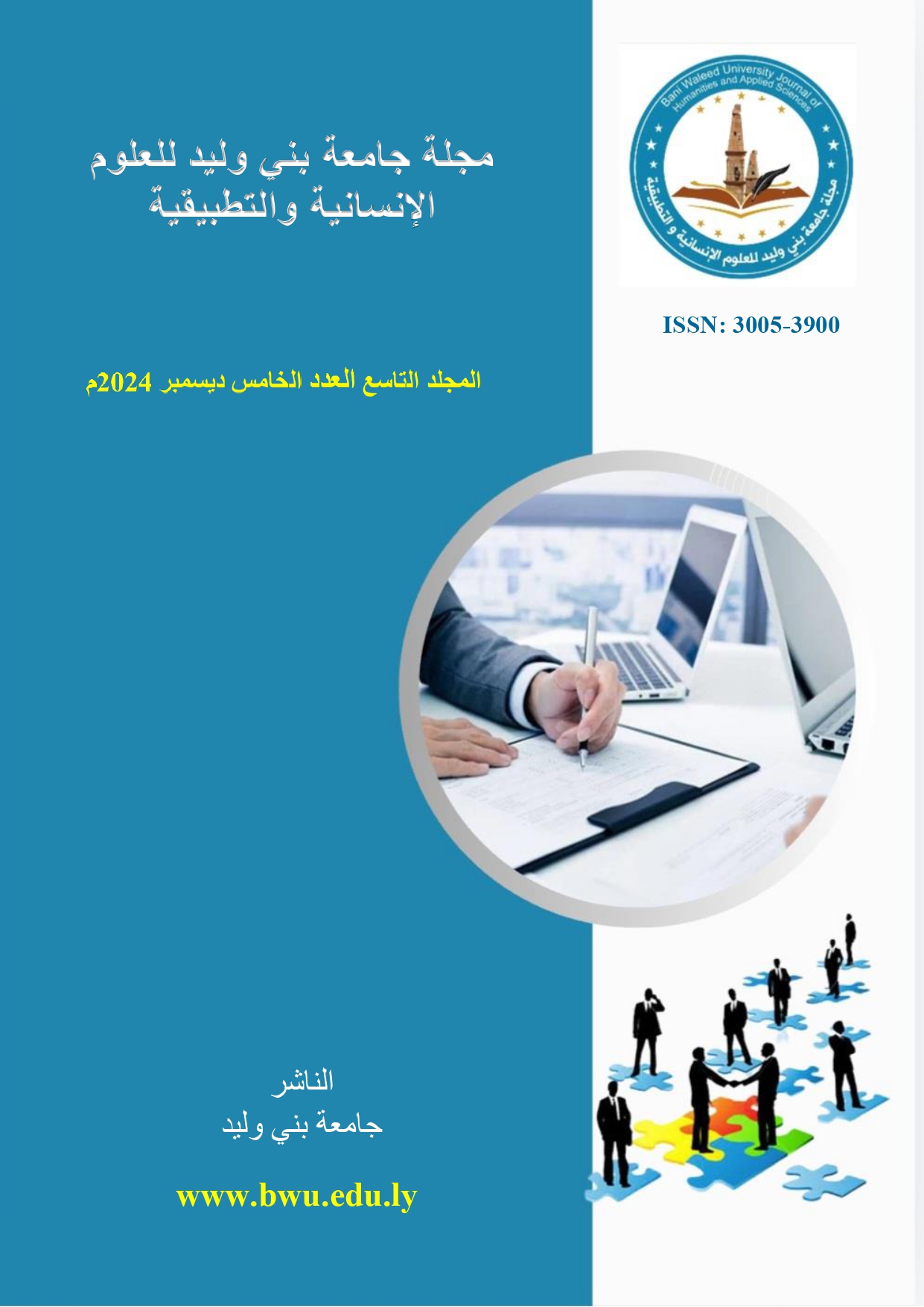Assessment of Heavy Metal Contamination in Fruit Juice Samples from Toubrk City, Libya
DOI:
https://doi.org/10.58916/jhas.v9i5.555Keywords:
Heavy metals, fruit juices, contamination, food safety, Atomic Absorption Spectroscopy.Abstract
In this study, the concentration of heavy metals in fruit juices available in Tobruk city, Libya, was estimated to assess the potential health risks associated with their consumption. Samples of commonly consumed juices were collected from local markets. Using atomic absorption spectroscopy (AAS), levels of heavy metals such as lead (Pb), cadmium (Cd), mercury (Hg), nickel (Ni), cobalt (Co), chromium (Cr), manganese (Mn), iron (Fe), copper (Cu) and zinc (Zn) were determined. The absence of cadmium, cobalt, chromium and mercury in all samples is reassuring, indicating compliance with safety standards in the production processes. However, the presence of varying levels of copper, manganese and lead raises concerns about potential health risks associated with consumption. The significantly high concentration of iron (51,360 mg/L) is particularly worrying, as many samples exceeded the safety limits set by international health organizations. These results raise significant concerns about food safety and public health in Tobruk, highlighting the need for regular monitoring and regulatory measures to mitigate the risk of contamination in fruit juices.
Downloads
References
Elbagerma MA, Alkherraz A, Amer A, Zubi A. Nutritional Quality of Some Commercial Fruit Juices Available in Libya. 2020;(September).
Hussein AMS, Hegazy NA, Kamil MM. Production nutritious juice blends containing bioactive healthy compounds. Egypt J Chem. 2022;65(3):333–9.
Abbasi H, Shah MH, Mohiuddin M, Elshikh MS, Hussain Z, Alkahtani J,...&. Quantification of heavy metals and health risk assessment in processed fruits’ products. Arab J Chem. 2020;13(12):8965–78.
Hegedus C, Pașcalău SN, Andronie L, Rotaru AS, Cucu AA, Dezmirean DS. The Journey of 1000 Leagues towards the Decontamination of the Soil from Heavy Metals and the Impact on the Soil–Plant–Animal–Human Chain Begins with the First Step: Phytostabilization/Phytoextraction. Agric. 2023;13(3).
Jalbani N, Ahmed F, kazi TG, Rashid U, Munshi AB, Kandhro A. Determination of essential elements (Cu, Fe and Zn) in juices of commercially available in Pakistan. Food Chem Toxicol. 2010;48(10):2737–40.
Alzahrani HR, Kumakli H, Ampiah E, Mehari T, Thornton AJ, Babyak CM,...& . Determination of macro, essential trace elements, toxic heavy metal concentrations, crude oil extracts and ash composition from Saudi Arabian fruits and vegetables having medicinal values. Arab J Chem. 2017;10(7):906–13.
Deka AK, Handique P, Deka DC. Ethnic food beverages with heavy metal contents: Parameters for associated risk to human health, North-East India. Toxicol Reports. 2021;8:1220–5.
Fathabad AE, Shariatifar N, Moazzen M, Nazmara S, Fakhri Y, Alimohammadi M, ...&.Determination of heavy metal content of processed fruit products from Tehran’s market using ICP- OES: A risk assessment study. Food Chem Toxicol. 2018;115(April):436–46.
Zeng Z, Lu Q, Xie Y, Jiang WQ, Zhang QJ. Determination of lead and cadmium in phosphoric acid by graphite furnace atomic absorption spectrometry. Yejin Fenxi/Metallurgical Anal. 2009;29(5):66–8.
Briffa J, Sinagra E, Blundell R. Heavy metal pollution in the environment and their toxicological effects on humans. Heliyon. 2020;6(9):e04691.
El-zwaey RS, Towier NH, Ahmida NHS, Busaadia AS, Amer SM. The Level of Some Heavy Metals in Canned Fruit Juices Collected from Some Benghazi City Markets. J Environ Sci Toxicol Food Technol. 2022;16(2):13–20.
Dehelean A, Magdas DA. Analysis of mineral and heavy metal content of some commercial fruit juices by inductively coupled plasma mass spectrometry. Sci World J. 2013;2013.
Borges FA, Costa LM, Tarley CRT, de Fátima Lima Martins G, Figueiredo EC. Lead determination in commercial juice samples by direct magnetic sorbent sampling flame atomic absorption spectrometry (DMSS-FAAS). Food Chem. 2023;413:135676.
Mehari T, Greene L, Duncan A, Fakayode S. Trace and Macro Elements Concentrations in Selected Fresh Fruits, Vegetables, Herbs, and Processed Foods in North Carolina, USA. J Environ Prot (Irvine, Calif). 1 2015;06:573–83.
Mohamed F, Guillaume D, Abdulwali N, Al-Hadrami K, Maher MA. ICP-OES assisted determination of the metal content of some fruit juices from Yemen’s market. Heliyon. 2020;6(9):e04908.
Ebrahimi-Najafabadi H, Pasdaran A, Rezaei Bezenjani R, Bozorgzadeh E. Determination of toxic heavy metals in rice samples using ultrasound assisted emulsification microextraction combined with inductively coupled plasma optical emission spectroscopy. Food Chem. 2019;289:26–32.
Morariu ID, Avasilcai L, Vieriu M, Lupu VV, Ioniuc I, Morariu BA,...&. A Comprehensive Narrative Review on the Hazards of Bee Honey Adulteration and Contamination. Giaouris E. J Food Qual. 2024;2024:3512676.
Jayakumar M, Surendran U, Raja P, Kumar A, Senapathi V. A review of heavy metals accumulation pathways, sources and management in soils. Arab J Geosci. 2021;14(20):1–19.
Zwolak A, Sarzyńska M, Szpyrka E, Stawarczyk K. Sources of Soil Pollution by Heavy Metals and Their Accumulation in Vegetables: a Review. Water Air Soil Pollut. 2019;230(7).
Abdel-rahman GN, Ahmed MBM, Sabry BA, Ali SSM. Heavy metals content in some non-alcoholic beverages ( carbonated drinks , fl avored yogurt drinks , and juice drinks ) of the Egyptian markets. Toxicol Reports. 2019;6(November 2018):210–4.
Joshi S, Gangola S, Bhandari G, Bhandari NS, Nainwal D, Rani A,...&. Rhizospheric bacteria: the key to sustainable heavy metal detoxification strategies. Front Microbiol. 2023;14(July):1–19.
Meng R, Zhu Q, Long T, He X, Luo Z, Gu R,...& . The innovative and accurate detection of heavy metals in foods: A critical review on electrochemical sensors. Food Control. 2023;150:109743.
Amlinger F, Pollack M, Favoino E. Heavy metals and organic compounds from wastes used as organic fertilisers. Final report for ENV. A. 2./ETU/2001/0024. Final Rep ENV A 2/ETU/2001/0024. 2004;(July):35.
Fatima N, Khan M, Shuaib Kabeer M. Evaluation of heavy metals content in the canned/packed fruit juices from local and imported origin in Lahore, Pakistan. J Food Saf Hyg. 2021;6(4).
WHO. Trace elements in human nutrition and health World Health Organization. World Heal Organ. 1996;1-360.
LNCSM (Libyan National Center for Standardization and Metrology), (2015). Drinking Water. LNS 82, Second edition.Tripoli-Libya.








